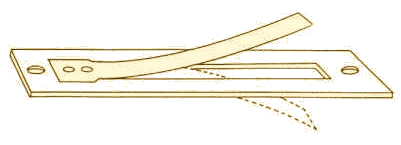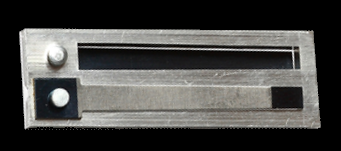Working mechanism of the accordion
Sound creation through the physics of free reed vibration.
Reed definition
A reed (tongue) is a thin strip of cane, metal or synthetic material, which vibration within an air column produces sound. | Saxophone reed (mouthpiece) 
|
Free reed definition
A reed is said to be free when it is fixed by one end and allowed to move on both sides of its resting position. The most illustrative and widely known free-reed instrument is the Jew's harp. | Working principle of a free reed 
|
Reed plates
As seen above, a free reed must be attached at one end. In the case of the accordion, it is riveted to a mounting plate. A reed plate can be made of: - Aluminium (basic models) - Aluminium alloy such as Duralumin (middle and high end models) Aluminum is light, but soft and less efficient at carrying sound waves. Duralumin is harder and more sonorous. Cuts are also sharper, and are adjusted using files for a more accurate result. |
Accordion reed fixed to its plate
|
Reed types
There are several types of reeds depending on quality. - Machine made reeds: found on low end models, generally mounted to a plate made of aluminium (or duralumin). - Typo A Mano reeds: hand mounted and adjusted, recognisable by their faceted rivet. - A Mano reeds: fully stamped out, adjusted and mounted by hand. Top-of-the-range quality performed by highly qualified and experienced craftsmen. | From left to right: Machine made, Tipo A Mano and A Mano 
|
Reed valves and sound production
In order for the reed to vibrate against air pressure, the reed must be secured over the plate and cover the air slot precisely. This leads to the reed bending and vibrating in one direction only. One plate is therefore pierced with two slots and fitted with two reeds for the bellows to play in both directions (pull and push). In order to conserve air and maximise its pressure, a leather or synthetic valve is placed over the opposite side of the slot. That way, the air can only travel through the slot in the direction that produces sound. This leather flap (which can be replaced by synthetic material on the treble) also plays an important role in shaping the sound produced. Too hard a valve will attenuate the sound. Too soft or mechanically flawed a valve will produce an unstable sound or various noises, so far as to even alter the tuning of the instrument. | Reed plate with leather flap.

|
Reed block: reed plate support and sound vector
Reed plates are mounted on a reed rank, generally made of wood, to operate each reed independently.
There are many reed rank designs, varying in wood type and the angle, finish, varnish applied.
The accordion reeds are usually held in place with beeswax and rosin, This method is the common and is used by the majority of Italian accordion makers. In certain renowned French factories, such as Cavagnolo and Maugein, the reed plates are nailed or screwed to a leather or cork joint.
The Cavagnolo factory even modified this process recently by screwing the reeds directly onto the rank’s wood. To achieve this, the reed ranks must be cut with extreme precision to ensure excellent sealing performance. The objective of this process is to optimize the transmission of vibrations to the wood by limiting the loss-inducing use of wax, cork or leather.
Wood reed rank with reeds pinned on leather. 
|







